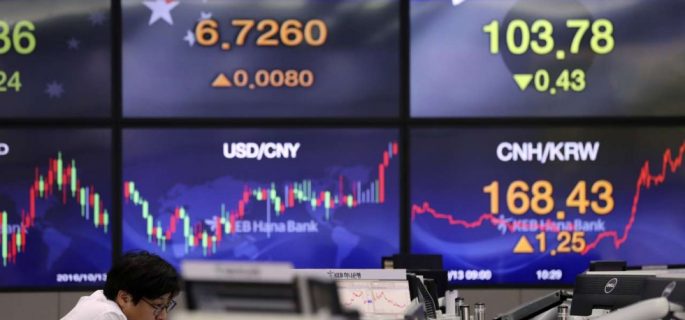The decline in global forex trading

Few surveys chart financial history and the changing structure and activities in financial markets as well as the Bank for International Settlements’ Triennial Central Bank Survey of foreign exchange and over-the-counter derivatives.
The 2016 Triennial survey covers the period 1997 to 2016. More than 1,200 financial institutions in 52 countries were polled and interviewed.
According to the survey, global forex trading fell for the first time since 2001.
Overall, international forex turnover declined to US$5.1 trillion per day in April 2016, from US$5.4 trillion in April 2013.
In particular, spot trading fell to US$1.7 trillion per day in April 2016, from US$2 trillion in 2013. Trading in most FX derivatives, particularly FX swaps expanded.
Emerging market currencies gained market share, especially the renminbi.
Besides slowing global trade after the 2008 financial crisis, the composition and risk appetites of market participants dramatically shifted during this period to favour more risk-averse institutions. Major regulatory reforms and increased capital requirements probably drove weaker institutions out of certain areas of the FX business.
The end of proprietary trading due to the Volker Rule and corporate clients’ new requirements after the financial crisis have likely provoked bank management to transact FX for hedging, rather than risk-taking purposes.
The retreat of leveraged players directly engaged in the FX market or who indirectly trade FX outside of their base currency showed how institutions adapted to macroeconomic and regulatory circumstances.
Between 2013 and 2016, FX trading by hedge funds and principal trading firms in London and New York dropped by 50 per cent and 10 per cent, respectively. It increased by 88 per cent in the Hong Kong SAR, more than doubled in Singapore and tripled in Tokyo, albeit from a smaller base.
Asian financial centres in total accounted for about 4 per cent of trading by hedge funds and principal trading firms, compared with 1 per cent in 2013.
The renminbi’s increasing liquidity is driving its globalisation. Renminbi turnover has approximately doubled every three years over the past decade and a half, making up 4 per cent of the total global turnover.
Financial leverage fell or reinvented itself. The drop in prime and retail brokerage FX flows is detrimental as they are a major supplier of leverage to institutions and individuals.
FX turnover via prime brokers fell sharply in 2016 by 22 per cent compared to 2013 and almost 30 per cent in spot markets.
Banks have been evaluating the profitability of their prime brokerage operations every year since the financial crisis.
Stricter regulatory reforms have resulted in falling overall profitability and pressures to deleverage are forcing changes or entirely eliminating the business.
BIS interviews confirmed that prime brokers have focused on retaining large-volume clients, such as principal trading firms engaged in market making.
Retail aggregators, smaller hedge funds and some high-frequency trading firms have been dropped.
Indeed, a prime brokerage manager from a top-tier bank explained how they reinvented their business and gamed the regulations and system to continue making lucrative fees.
I asked him if the shrinking number of hedge funds due to poor performance or higher lending requirements had affected his business. He adroitly replied that business is better than ever in Asia after shedding themselves of hedge funds.
If his risk managers had pointed out that their balance sheet couldn’t finance all the hedging activities of a huge mainland oil company, they would’ve advised the client to set up its own oil and FX trading dealing operation rather than lose the client.
The bank would lend to it, subject to collateral, as a new financial enterprise. It would even advise the traders on how to maintain their hedges.
So risk would merely be disguised and shape shifted in another direction. Think of all possibilities and fees you could earn with a captive client who gains enough confidence to speculate rather than just hedge.
Non-bank, market makers and hedge funds disguised as trading sites have also emerged as a new type of liquidity provider. They extend their capabilities beyond broking by trading directly with clients. Financial technology has become easier for parties to access and they have been encouraged and cultivated by regulations to change trade execution methods and platforms. Digital platforms are changing the entire meaning and function of trading relationships.
Top-tier dealer banks have nonetheless consolidated their position as key liquidity providers. However, the uncertain future not covered by the survey is how a smaller and changing the FX market affects risk warehousing and how risk is distributed in the market.
Market risk is direct function of liquidity conditions. It also threatens the effectiveness of the hedging strategies of all FX users.
Source: South China Morning Post





























